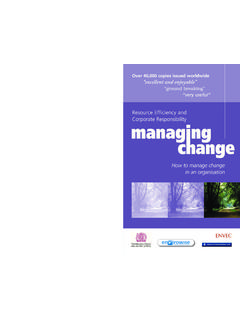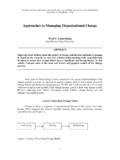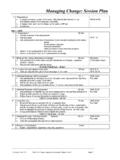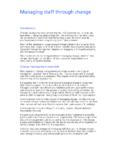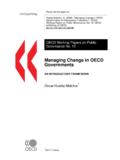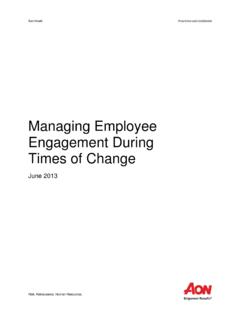Transcription of Managing complexity and change in a new landscape
1 Managing complexity and change in a new landscapeGlobal survey on asset management investment operationsF or our latest survey on asset management investment operations, we contacted chief operating officers (COOs) and heads of investment operations at traditional asset managers. We spoke with 40 leading global asset managers headquartered in the Americas and Europe with assets under management (AUM) spanning US$5 billion to more than US$1 trillion, with the majority of respondents Managing between US$50 billion and US$500 billion. Our survey seeks to provide insight into four primary questions: What are the market forces and key drivers causing asset managers to assess and alter their existing operating models, operations and supporting technologies? What are the key areas of focus, including firm priorities and investments? What are the similarities and differences between small, medium and large asset managers, including geographic nuances?
2 What leading practices contribute to success, and what does it look like today?Various market forces and pressures, from increasing competition to sweeping regulatory change , are forcing global asset management firms to evaluate and evolve their operating models to support their business strategies: Competition is driving asset managers to focus on brand management and grow AUM through innovative new products, distribution channels and geographies. The changing and increasingly complex global regulatory environment is requiring asset managers to invest significantly in people, infrastructure, process, systems and data. Investors, regulators, boards and senior management are demanding more transparency and reporting, including new approaches to risk management and governance, as a result of the rapidly evolving global, regional and local regulatory and market landscape . Pressures to reduce costs and improve margins are causing firms to focus on operational efficiency and rationalize their existing product suite and asset classes.
3 Rapid technology advancements from software vendors and third-party asset servicers have enabled firms to reduce infrastructure complexity and cost by rationalizing the number of applications, which has increased the opportunities for outsourcing. These complex forces require firms to implement enterprise-wide transformational change spanning people, processes and controls, data, and business applications. Our survey indicates that leading asset management firms are now implementing change at an unprecedented and managers of leading organizations are continually assessing their global operating model. Standing still is not an option. Operating models must evolve to support business strategies, safeguard competitive position and control costs in an increasingly complex regulatory s 2013 survey of asset management operations provides insights on how leading firms are transforming their organizations to execute winning business strategies.
4 We hope you find this report interesting and useful. If you would like to discuss our findings in greater detail, please contact one of the members of our BirkinPartner and Global Wealth & Asset Management Advisory Leader, Ernst & Young LLPAlan FishPartner and Americas Wealth & Asset Management Advisory Leader, Ernst & Young LLP12 Managing complexity and change in a new landscape Global survey on asset management investment operations |Leaders of global asset management firms are driving their operations and technology organizations to transform business processes and technology infrastructures. To enable long-term competitiveness, firms are redefining their global operating models through: A global footprint that maximizes the use of the 24-hour clock for business processes and technology development while enabling trading across multiple time zones The next generation of shared services organizations, outsourcing and data management programs to promote flexibility and responsiveness to changing investor and regulatory demands Cost-management programs that include product rationalization, assessment of distribution channels, a critical review and rationalization of global business applications, and ongoing strategic assessment of the use of low-cost locations While specific areas of focus vary across small, medium and large firms.
5 A number of common themes have emerged as firms reposition their global operating models in response to the convergence of long-term downward pressure on management fees and increased operating asset growth by expanding global distribution channels and focusing on a premier client experience and brand managementIn response to declining margins, firms are focusing their corporate strategies on distribution and brand management for asset growth. Across all respondents, improving distributions channels is the number one driver in changes to the firm operating model. US managers are expanding their brands in Europe, while firms in all locations are assessing how to expand the direct-to-consumer model. US firms rebounded from the financial crisis more quickly than their European counterparts and are investing significantly in marketing and brand awareness in Europe in an effort to increase market a strategic approach to complying with a dynamic regulatory environment Global firms must comply with a changing and complex regulatory environment that places significant demands on not only the compliance organization s people and technology, but also on the core investment operations infrastructure overseen by the COO.
6 Leading firms are differentiating their capabilities and competitiveness by holistically assessing and implementing strategic change programs to address a multitude of regulations by a multitude of regulators with all their overlaps and conflicts. While challenges and competitive opportunities span business processes and legacy applications, data management and its associated challenges of quality, timely delivery, effective analytics, and reporting are paramount. Medium to large global asset managers are implementing new and enhanced compliance programs that require changes to existing organizational structures, functional alignment, processes, systems and data to manage global regulatory compliance. For individual firms, the cost of compliance is substantial. For 44% of all firms globally, the cost of compliance represents between 11-25% of their operations and implementing the next generation of global location strategy Over the past decade, global expansion has been heavily focused on technology development and testing, as well as performing selected operational functions such as reconciliations.
7 And this expansion has been traditionally concentrated in a few locations. As medium and large forward-looking asset management firms evolve to the next generation of offshoring, they are increasingly looking to leverage their global footprint by creating a global operating model, where the technical and data infrastructure supports an increased number of business processes across the front-, middle- and back-office operations. Firms are creating global centers of excellence in a more diverse set of low-cost locations, balancing such trade-offs as proximity to senior management, cost of travel, information security, depth and breadth of skilled resources, and political and environmental factors. While the majority (55%) of all responding firms indicated that their primary location strategy was to maximize the uses of near-shore locations, for smaller and some midsized firms, nearshoring remains the more cost-effective approach.
8 For US firms of all sizes, the tax advantages of the offshore locations are a primary driver for diversifying from traditional financial center hubs. Where scale supports the strategy, these firms are moving from function-specific relocations to taking a cross-functional approach that effectively takes a critical mass of an organization, from senior management on down, and relocates to a lower-cost location. This approach has the added benefit of providing site diversification and enabling business continuity planning. Expanding the use of third-party outsourcing throughout the operating modelAsset servicers are a fundamental component of an asset management firm s global operating model. With the exception of a minority of firms, the question is no longer Executive summary3whether to outsource; instead, firms are considering which functions can be outsourced, the optimal number of providers to use and how third-party providers can be integrated effectively to enable timely data access by the enterprise.
9 Outsourcing has grown significantly in the last few years as firms drive outsourcing into the middle office and closer to the functions that traditionally interact with the front-office investment team, such as performance measurement and attribution. Even firms that are unlikely to outsource a significant number of functions use third-party providers for selected products such as exchange-traded funds (ETFs) or Undertakings for Collective Investment in Transferable Securities (UCITS). For example, 68% of the responding firms describe their target operating model as a combination of outsourcing and in-house operations, with 62% of firms employing an outsource model that relies on one or two strategic cost savings in existing shared services organizationsEstablishing shared services can serve many purposes: streamlining operations prior to outsourcing, preparing for relocating all or part of the organization, or simply reducing operating costs and increasing the effectiveness of the control environment for processes viewed as too mission-critical to outsource.
10 Centralizing and standardizing business processes, such as reconciliation or technology functions such as testing and data services, are mature practices across the industry. Seven in 10 firms surveyed maximize the use of shared services organizations for functions performed in house. While there remain a few smaller firms (under US$100 billion) that have yet to maximize shared services organizations, the structure is fully adopted by 100% of the largest firms leading firms, the next phase of shared services organizations is focused on driving down costs through reassessing the location of the centers, as well as reviewing business functions that may have previously been considered too complex or close to the customer to be moved into a shared services organization. In addition, top-tier firms are adopting process excellence and efficiency methodologies that originated in manufacturing, such as lean process improvement, to drive efficiency, scale and cost savings in existing or new shared services and maturing data management and information security programs Operations and technology leadership in top-tier firms are driving their organizations to implement world-class data management standards.










